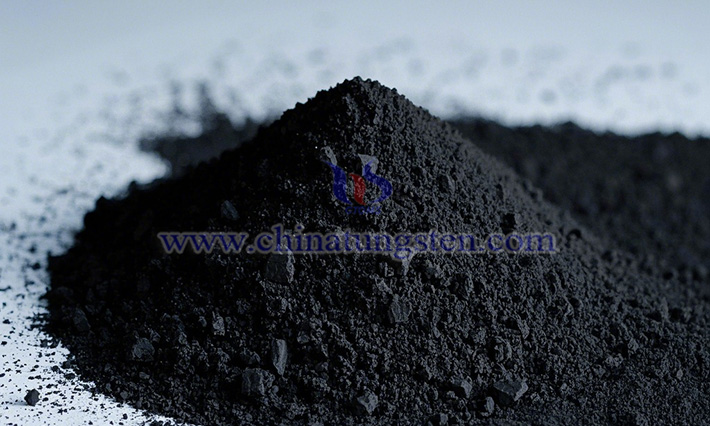What Are the Thermoelectric Properties of Tungsten Disulfide?
- Details
- Category: Tungsten Information
- Published on Friday, 21 March 2025 16:55
Tungsten disulfide (WS₂) produced by CTIA GROUP LTD is a typical tungsten compound. In addition to its excellent catalytic, lubricating, and optical properties, it also exhibits outstanding thermoelectric performance, making it highly regarded in the field of energy conversion and utilization.
The thermoelectric properties of WS₂ are based on the Seebeck effect, Peltier effect, and Thomson effect. The Seebeck effect refers to the generation of a thermoelectric voltage, and thus a current, when a temperature difference exists across the two ends of WS₂. Conversely, the Peltier effect occurs when a current passing through WS₂ creates a temperature difference between its two ends. The Thomson effect describes the absorption or release of heat when a current flows through a conductor with a temperature gradient. In practical applications, WS₂ can leverage these thermoelectric effects to achieve mutual conversion between thermal and electrical energy, such as in thermoelectric power generation and refrigeration.

The key parameters of thermoelectric performance include the Seebeck coefficient, electrical conductivity, and thermal conductivity.
Seebeck Coefficient: The Seebeck coefficient reflects the ability of WS₂ to convert a temperature difference into a thermoelectric voltage. Studies indicate that the Seebeck coefficient of WS₂ is closely related to carrier concentration and band structure. Generally, techniques such as appropriate doping or layer number control can optimize the Seebeck coefficient. For instance, introducing a suitable amount of impurity atoms through chemical doping alters the electronic structure of WS₂, thereby adjusting the Seebeck coefficient. Theoretical calculations and experimental measurements show that under specific conditions, the Seebeck coefficient of WS₂ can reach certain values, laying the foundation for its application in thermoelectric conversion.
Electrical Conductivity: Electrical conductivity determines the ability of WS₂ to conduct electric current. High-quality WS₂ crystals exhibit good electrical conductivity, though it is influenced by factors such as crystal defects, impurities, and environmental conditions. Defects like vacancies or dislocations scatter carriers, reducing conductivity, while appropriate surface modification or optimized preparation processes can minimize defects and enhance conductivity. In thermoelectric applications, it is necessary to maintain high electrical conductivity while improving the Seebeck coefficient to achieve efficient thermoelectric conversion.
Thermal Conductivity: Thermal conductivity measures the ability of WS₂ to conduct heat. A lower thermal conductivity is beneficial for improving thermoelectric conversion efficiency, as it reduces heat loss from the hot end to the cold end. The thermal conductivity of WS₂ arises from both lattice vibrations and electronic contributions. In the layered structure of WS₂, weak interlayer van der Waals forces enhance phonon scattering, thereby reducing lattice thermal conductivity. By controlling the crystal structure, introducing nanostructures, or inducing defects, thermal conductivity can be further lowered, enhancing thermoelectric performance.

Factors Affecting the Thermoelectric Performance of WS₂
Crystal Structure and Layer Number: The crystal structure of WS₂ significantly impacts its thermoelectric properties. Different crystal phases of WS₂ exhibit varying atomic arrangements and electron distributions, leading to differences in thermoelectric performance. Additionally, the number of layers plays a critical role. As the layer number decreases, quantum confinement effects become more pronounced, altering the band structure and, consequently, affecting thermoelectric parameters such as the Seebeck coefficient and electrical conductivity. For example, single-layer WS₂ may offer unique thermoelectric advantages compared to multilayer or bulk WS₂.
Doping and Defects: Doping with different elements can modify the electronic structure of WS₂, adjusting carrier concentration and mobility, thus influencing thermoelectric performance. The introduction of suitable impurity atoms can increase carrier concentration, enhance electrical conductivity, and optimize the Seebeck coefficient. However, defects such as vacancies or substitutional impurities scatter phonons and electrons, affecting thermal and electrical conductivity. Therefore, precisely controlling the type, concentration, and distribution of dopants and defects is a key strategy for optimizing the thermoelectric properties of WS₂.
External Conditions: External factors such as temperature and pressure also influence the thermoelectric performance of WS₂. Temperature variations not only affect the thermal motion of carriers but also impact the stability of the crystal structure, thereby altering thermoelectric parameters. Applied pressure can modify the lattice constants and electronic structure of WS₂, providing a means to tune its thermoelectric properties. In practical applications, these external factors must be comprehensively considered based on the specific operating environment to evaluate their effects on the thermoelectric performance of WS₂.
- Rare Earth Manufacturer & Supplier, Chinatungsten Online: www.chinatungsten.com
- Tungsten News & Prices of China Tungsten Industry Association: www.ctia.com.cn
- Molybdenum News & Price: news.molybdenum.com.cn
- Tel.: 86 592 5129696; Email: sales@chinatungsten.com



 sales@chinatungsten.com
sales@chinatungsten.com